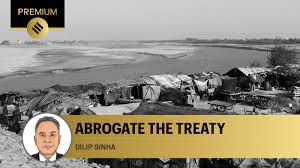06 May 2025 Indian Express Editorial
What to Read in Indian Express Editorial( Topic and Syllabus wise)
Editorial 1 : Abrogate the Treaty
Context: Indus Waters Treaty (IWT)
Introduction: The Indus Waters Treaty (IWT) is cited as an outstanding example of river water sharing because of its scale and the hostility between the signatories. But it has been unfair to India and should be abrogated by India.
Structural Framework of the IWT
- Division of Rivers
- Eastern Rivers: Ravi, Beas, Sutlej – India granted full rights.
- Western Rivers: Indus, Jhelum, Chenab – Pakistan granted near-exclusive rights (80% of total water).
- India allowed limited use: Agriculture and run-of-river hydroelectric projects with minimal storage.
- Dispute Resolution Mechanisms
- Pakistan’s right to inspect Indian projects in J&K.
- Two options for disputes: Neutral Expert or Court of Arbitration.
- World Bank acts as custodian and appoints adjudicators.
- Financial Arrangements
- India paid Pakistan 62 million pounds to Pakistan for building link canals to switch from the eastern to the western rivers.
- US, UK, Canada, West Germany, Australia and New Zealand underwrite a development fund of $1 billion for the construction of dams and irrigation networks in both countries.
- Pakistan got an additional $315 million.
- World Bank funded dams in both countries.
Inequities in the IWT
- Disproportionate Water Allocation
- Western rivers (allocated to Pakistan) hold 80% of water, despite India having 39% of the Indus Basin. Pakistan has 47% of the basin.
- China (Tibet) and Afghanistan hold the remaining basin but are not treaty signatories.
- Absence of Exit Clause
- Unlike the Columbia River Treaty (1961), which allows withdrawal with a 10-year notice, the IWT is permanent.
- It contradicts the Vienna Convention, which permits treaty termination under fundamental changes in circumstances.
Pakistan’s Non-Cooperative Approach
- Systematic Objections: Pakistan has blocked or challenged every Indian project in J&K.
- Examples
- Salal Hydroelectric Project(1970s): India conceded to design changes, leading to siltation issues.
- Baglihar Dam(2005): Neutral Expert upheld India’s spillway design but mandated minor changes.
- Kishanganga Arbitration(2013): Court of Arbitration approved the project with design tweaks.
- Exploitation of Dispute Mechanisms
- Pakistan has simultaneously invoked Neutral Expert and Court of Arbitration for the same projects (e.g. Ratle Hydroelectric Project).
- World Bank initially resisted dual processes but relented under pressure.
International Law and the IWT
- Evolution of Water-Sharing Norms
- UN Watercourses Convention(1997): Advocates equitable and reasonable sharing but lacks ratification by India, China, and Pakistan.
- Contrast with IWT: The treaty predates modern codification and remains more rigid.
- Global Precedents
- Turkey refuses binding agreements with Syria and Iraq over Tigris-Euphrates.
- China avoids water-sharing pacts with downstream Southeast Asian nations.
Current Status and Implications
- Stalemate in 2025
- India suspended the treaty in response to Pakistan’s refusal to engage in bilateral talks.
- Permanent Indus Commission inactive since May 2022.
- India’s Options
- Temporary Relief: Keep treaty in abeyance but risk retroactive violations.
- Treaty Revision: Demand renegotiation to address inequities (unlikely given Pakistan’s hostility).
- Abrogation: Exit the treaty entirely, following precedents like the Columbia River Treaty.
Conclusion: The IWT remains a relic of Cold War geopolitics, disproportionately benefiting Pakistan. India’s options are limited by the treaty’s rigidity and Pakistan’s adversarial stance. A comprehensive revision or abrogation may become inevitable to address India’s long-term water and energy security needs.
Editorial 2 : What Counts in Caste Census
Context: Caste Census
India’s Caste Census Move
- Modi Government’s Shift: BJP historically opposed caste-centric politics but now endorses a caste census.
- Political Strategy: Aimed at expanding BJP’s base among non-dominant OBCs and SCs, despite risking upper-caste backlash.
- Symbolic Significance: State acknowledgment of caste inequality’s ground reality after decades of evasion.
Political Dynamics
- BJP’s Historical Stance
- Anti-Mandal Rhetoric: Earlier dismissed caste politics as divisive to Hindu unity.
- Strategic Pivot: Gradually courted OBCs and SCs to counter Mandal-driven parties.
- Implications of the Caste Census
- Electoral Timing: Announced ahead of Bihar elections, raising questions about BJP’s intent to domesticate Mandal.
- Internal Tensions: Risk of alienating upper-caste loyalists while appealing to marginalized groups.
Societal and Policy Implications
- Need for Data-Driven Policies
- Addressing Exclusion: Census data could inform affirmative action for marginalized castes.
- Overcoming Historical Reluctance: Both BJP and Congress-led UPA previously avoided caste enumeration.
- Concerns and Counterarguments
- Fear of Division: Critics argue caste census may solidify social hierarchies.
- Reality Check: Caste already structures spatial and social realities (e.g. village clusters).
Historical Precedents and Lessons
- Mandal Commission (1990)
- Unintended Consequences: VP Singh’s decision triggered BJP’s Rath Yatra but reshaped caste politics permanently.
- Long-Term Ripples: Advani’s mobilization indirectly strengthened Hindutva, yet Mandal’s legacy persists.
- Political Opportunism vs. Structural Change: Caste census may be politically timed, but like Mandal, its effects could transcend intentions.
Challenges
- Internal Fragmentation: Dominant vs. marginalized groups within OBCs and SCs complicate proportional representation.
- Social Justice Framework
- Prioritizes backwardness alleviation over numerical quotas.
- Allows cross-caste coalitions (e.g. BSP’s bahujan-savarna alliances in UP).
Way Forward
- Key Considerations
- Data Utilization: Will governments prioritize social justice or token representation?
- Political Accountability: Census design (questionnaire, timeline) will reflect BJP’s balancing act.
- Broader Impact
- Policy Potential: Evidence-based affirmative action could address systemic exclusion.
- Legacy of Mandal: Even politically motivated moves can catalyse transformative social change.
Conclusion: While the BJP’s motives are debated, the caste census’s success hinges on translating data into equitable policies that uplift the most marginalized, not just amplifying dominant caste voices.
![]()


